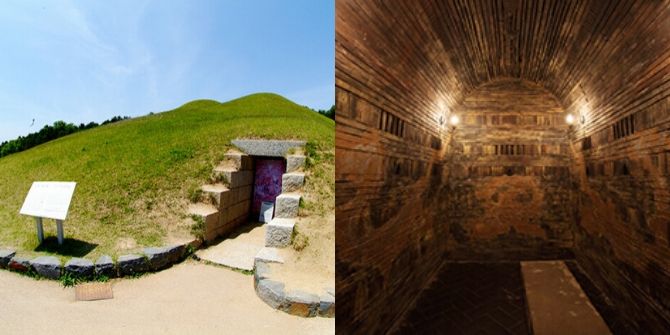Chanyeol EXO Reveals the Difference in Feeling When Singing in a Group and Solo
Known as a member of a group and a soloist, Chanyeol reveals his feelings when singing his second song.

Kapanlagi.com - King Muryeong's tomb is one of the world's heritage sites that has been discovered. King Muryeong was the 25th king of the Baekje kingdom, one of the Three Kingdoms of Korea. He ruled from 501-523.
As quoted from the Voluntary Agency of Network Korea (VANK), he made his best efforts to restore stability and the economy. He implemented many political reforms and actively engaged in trade with other countries, such as China and Japan.
King Muryeong's tomb is the only royal tomb from the Three Kingdoms Period that has been identified. How was King Muryeong's tomb discovered?

King Muryeong's Royal Tomb © visitkorea.or.id
King Muryeong's tomb is built from a stack of brick. Its distinctive brick chamber reveals the cultural exchange between Baekje and South China. This chamber is constructed with rectangular bricks stacked in four rows and one column. The walls of the bricks are adorned with intricate lotus flowers.
The ceiling is made of trapezoidal-shaped bricks. The bricks also have inscriptions to mark the location. Additionally, the ceramics and Chinese coffins made from Japanese umbrella tree in the tomb are another indication of Baekje's openness and international trade.

Ancient Tomb Exhibition (left) & Relics at Gongju National Museum (right) © visitkorea.or.id
According to the history described in KBS World, King Muryeong's Baekje tomb was discovered in 1971 during the repair of another tomb's drainage system. The memorial inscription at the entrance indicates that the tomb was built for King Muryeong and his queen. This is very rare as not many ancient tombs can be identified.
King Muryeong and his queen were buried together, along with over 2900 excavated artifacts, including the king and queen's crown ornaments, golden coffins, a large sword with dragon and phoenix decorations, silver bracelets with detailed engravings, and other accessories. And uniquely, the tomb remains intact. The tomb's artifacts can provide insights into Baekje's international relations at that time. There are 17 items that have been designated as Cultural Heritage Sites.
As quoted from visitkorea.or.id, the excavated tombs are now closed for preservation, but the interior of Tomb No. 6 and King Muryeong's Royal Tomb have been reconstructed and made accessible to visitors.
(kpl/mit)
Cobain For You Page (FYP) Yang kamu suka ada di sini,
lihat isinya
Known as a member of a group and a soloist, Chanyeol reveals his feelings when singing his second song.
G-Dragon, known as a trendsetter, often changes his hair style and color since his debut era. What are his transformations like?
What flavor of mochi do you think suits Jimin BTS's charm, ARMY?
No one expected that Ryujin ITZY's top when performing was made from underwear. Is it true?
Ashanty has proven herself to be a big fan of this actor. She even named her dish 'Ayam Hyun Bin'.
Chae Yi is known to have been a trainee at Big Hit Entertainment.
Here are some new Korean dramas that will start airing in April 2020. What are they?
Wheesung was found unconscious in the bathroom while under police surveillance. What's the story?
One of the legacies of the Joseon Dynasty is the royal tombs. It is very rare to have well-preserved royal tombs of a dynasty throughout the world after passing centuries. What are some interesting facts about the royal tombs of the Joseon Dynasty?
This Original Korean Calendar System was created in 1443, or the 15th year of King Sejong's reign during the Joseon Dynasty. What is the history behind its creation?
Have you ever heard of Arirang, a Korean folk song? Here are some interesting facts about Arirang.
Joseonmal Keunsajeon (Great Korean Language Dictionary) which became the first Korean language dictionary. The dictionary has been lost since it was confiscated by the police during the Japanese Occupation from 1910 to 1945. What is its history like?